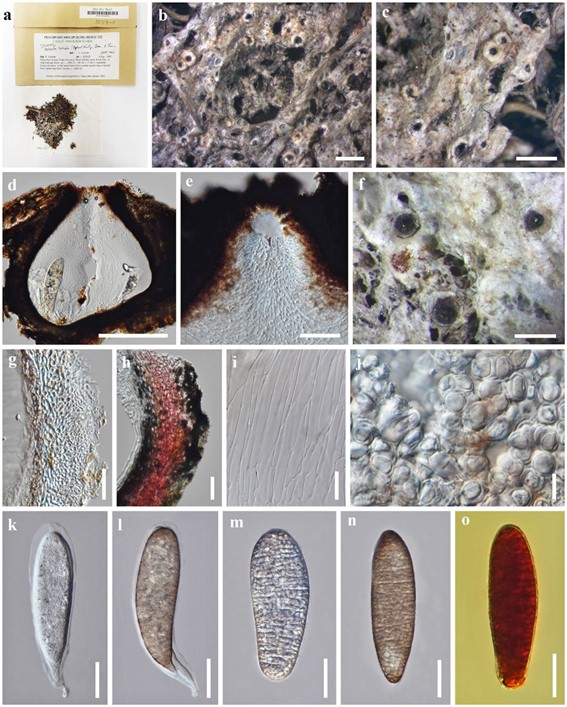Aptrootia Lücking & Sipman in Lücking et al., Lichenologist 39: 188 (2007).
MycoBank number: MB 29134; Index Fungorum number: IF 29134; Facesoffungi number: FoF 08786; three morphologically and phylogenetically defined species (Aptroot and Lücking 2016; Lücking et al. 2016, 2017).
Lichenized on bark or bryophytes or soil in terrestrial, chiefly montane tropical forest habitats. Thallus distinctly corticate, yellow-brown to mostly green, or ecorticate and greyish. Photobiont Trentepohlia. Ascomata solitary, immersed to erumpent, brown-black but usually covered by thick thallus layer except for ostiolar area, globose to pear-shaped or ovoid, coriaceous to carbonaceous, ostiolate, ostiole apical. Involucrellum reduced. Excipulum prosoplectenchymatous, colorless to brownish. Hamathecium comprising 0.5–1 µm wide paraphysoids, hyaline, straight, branched and anastomosing, embedded in a gelatinous matrix. Asci 1(–2)-spored, bitunicate, fissitunicate, oblong- ellipsoid, short pedicellate, with a non-amyloid ocular chamber. Ascospores oblong-ellipsoid, initially hyaline and I+ amyloid, but soon becoming dark brown, richly muriform, weakly distoseptate, wall smooth to granular ornamented, outer wall easily breaking under pressure, with gelatinous sheath. Pycnidia unknown.
Chemistry: no substances detected by TLC.
Type species: Aptrootia terricola (Aptroot) Lücking, Umaña & Chaves in Lücking et al., Lichenologist 39: 188 (2007).
Notes: For key and discussion see Aptroot and Lücking (2016). The genus currently includes three species (Fig. 78).

Fig. 78 Aptrootia terricola (Sipman 35503; f, j: Sipman 51849). a Herbarium package and specimen. b, c, f Thallus with ascomata. d Vertical section through an ascoma. e Ostiolar region with periphyses. g–h Perithecial wall in thin section, and the outer layer become reddish in 10% KOH. i Paraphysoids. j Trentepohlioid photobiont. k, l Asci. m, n Ascospores. o Ascospore in Lugol’s iodine. Scale bars: b, c = 1 mm, d = 200 µm, e, k–n = 50 µm, f = 500 µm, g–i = 20 µm, j = 10 µm
Species
